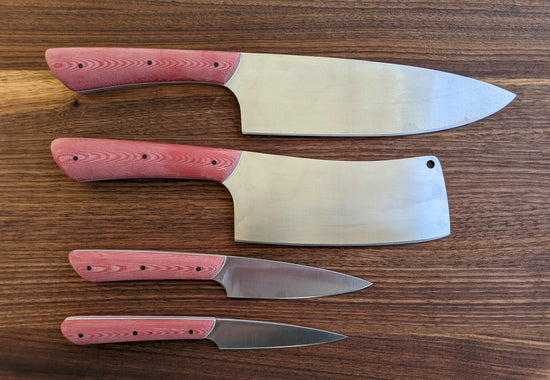Types of Kitchen Knives
-

Western, European, and German are all synonyms used to describe the classic kitchen knife as we all know it. The image that comes to mind has a curved blade running from the tip down into a wide flatter section closer to the handle. The handle is in line with the spine and shaped to fit the hand. They have heavy steel bolster between the blade and the handle for weight distribution. They are usually full tang construction; the steel runs the full length of the knife and can be seen between the handle slabs. They tend to be heavy and a bit ungainly in the hand. This design works well with a rocking style cut.
Chef Knife is the iconic image that comes to mind when you think about a kitchen knife. The big knife we use daily to prepare meals. Always used against a cutting board. They typically have 7-12 inches long blades.
Paring knife is the second iconic image that comes to mind as the small knife in the kitchen. Often used freehand while peeling fruits or vegetables. They typically have 3-4 inches long blades.
Serrated or bread knife is the knife we use to saw through a loaf of bread or occasionally tomatoes. The advantage of a serrated edge is that they remain sharp for an extended period. The tip of teeth are not the cutting edges; the sharp edge is the space between the tips. The tips merely protect the cutting edges from the cutting board, which is why they remain sharp longer. Tomato knives typically have 5-6 inches long blades, with a fork at the tip while bread knives are quite a bit longer, 8-12 inches long blades, usually with a blunt tip.
Utility knife is the in-between knife. Bigger than a paring knife but smaller than a chef knife. They work better against a cutting board that a paring knife, but some are a bit too large for freehand work. They typically have 5-6 inches long blades.
Japanese knives, traditional and modern. Traditional Japanese knives have a flatter shape to the blade, sometimes completely straight and usually single beveled. They are used in a slicing motion, forward or rearward. Some are used in a vertical chopping motion. They are traditionally constructed with a hidden tang, the steel ends short in the handle. This makes them lighter weight and slightly forward balanced. They are highly specialized, and all have unfamiliar names. There are knives used only to slices puffer fish and knives used only to fillet eels. There is even one used solely to pin the eels head to the board while filleting it. There are a few modern Japanese style multipurpose knives, most of which have double beveled blades.
Santoku is a relatively modern knife by Japanese standards. If you have a block of kitchen knives, you may even own on. It would be that one knife that stands out as different from the rest of the set. It has a flatter blade but maintains just enough curvature at the tip to make rocking cuts. The blade will be thinner and lighter that the rest of the set and it will cut better that all of them. It is often referred to as the knife of three virtues. Usually thought of as the ability to work well on fish, meat, and vegetables. To the Western mind all knives should be able to do this, but to the Japanese this was a novelty. Typically, with a 6-8 inches long blade.
Gyuto is essentially a modern Japanese copy of the Western Chef Knife. Typically, thinner, and lighter and usually with a partial tang construction. Typically, 8-11 inches long blade.
Petty is very similar to the western Utility knife. The name is a derivative of the French word petite, meaning small. A midsized knife for general purpose cutting but with the flatter blade profile typical of traditional Japanese knives. Usually, with a 5-7 inches long blade.
Kiritsuke is a long multipurpose blade with a straight section near the handle and a slight curve near the tip. The tip is always a reverse tanto. A straight section running from the point back toward the spine at an angle. Generally, of hidden tang construction. Typically, with an 8-12 inches long blade. This is one of the few traditional Japanese knives that is multipurpose in nature. Santoku, Gyuto and Petty are all relatively modern Japanese style knives.

